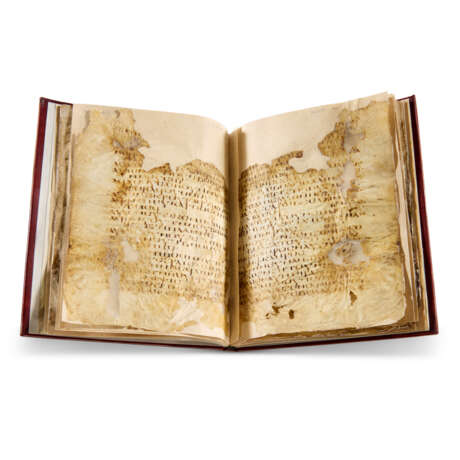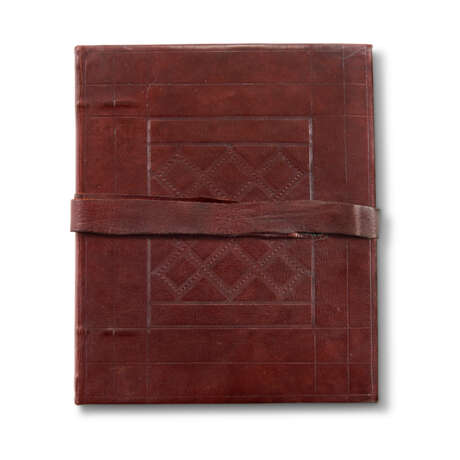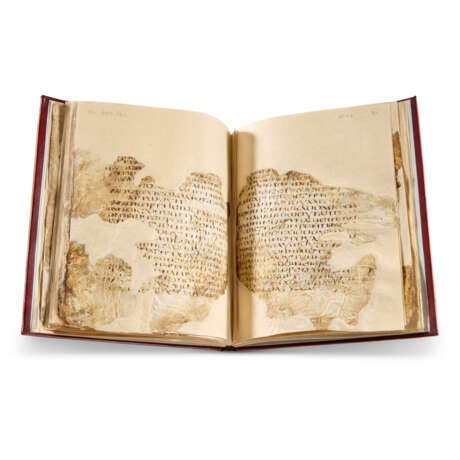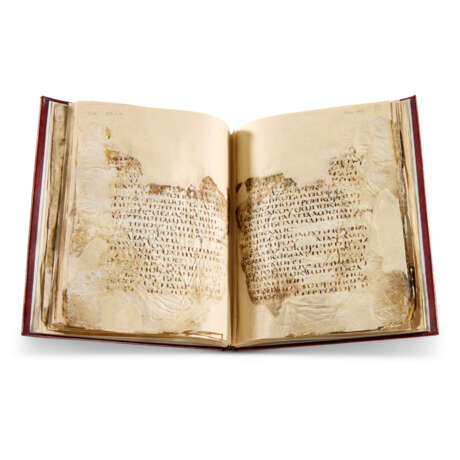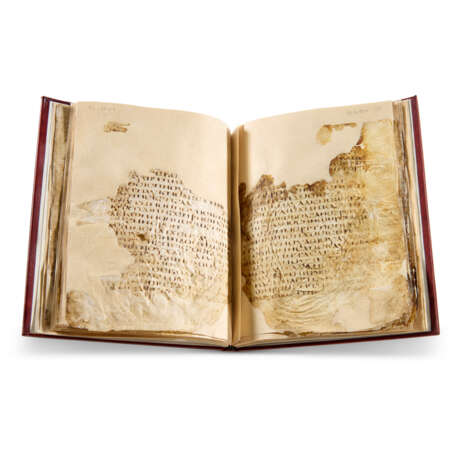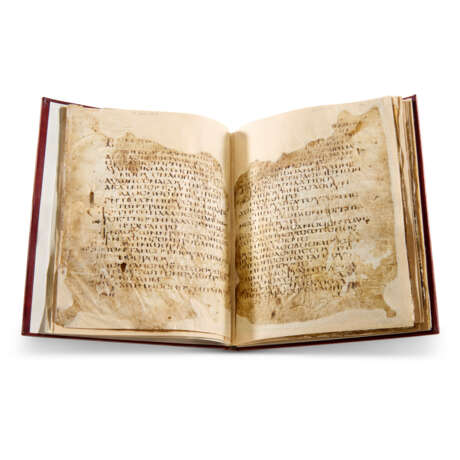ID 1214884
Lot 3 | An early Sahidic Psalter
Estimate value
£ 150 000 – 250 000
Psalter, in the Sahidic dialect of Coptic, manuscript on vellum [Upper Egypt, 5th century]
A substantial fragment of an early Coptic Psalter and an extremely important witness to the early circulation of the Sahidic Bible.
c.200 x c.160mm. 12 substantially complete leaves and 6 fragmentary leaves set in 22 leaves of modern conservation paper, up to 27 lines written in a single column in brown ink in a very fine large upright Coptic uncial, ruled space: c.155 x 110mm, text partly indented 'per cola et commata', some initial letters with calligraphic flourishes extending into the margins (the leaves fragmentary, stained and cockled). Bound in modern (1992) brown-red morocco with Coptic-style tooling, wrap around strap, by Aquarius. In a fitted cloth box.
Provenance:
(1) By repute and according to previous cataloguers, the present manuscript was produced for use in the famous library of the White Monastery (or the Monastery of Abba Shenouda), one of the most important Egyptian monasteries of the 4th through 12th centuries, located near the Upper Egyptian cities of Tahta and Sohag and founded by Apa Pegol, an uncle of Shenoute. The first fragments of manuscripts from the White Monastery came to Europe in 1778, acquired without knowledge of their provenance by Cardinal Stefano Borgia (1731-1804), and are today preserved in the libraries of Naples and Rome (see W.E. Crum, Catalogue of the Coptic Manuscripts of the British Museum, 1905, pp.ix-xvii). Subsequently, collections were formed in England by Henry Tattam and Robert, Lord Curzon, whose Visits to Monasteries in the Levant, 1849, vividly describes his efforts to find such manuscripts for his collection. But it was only with Gaston Maspero's visits to Egypt at the end of the 19th century that the origin of these manuscripts was finally determined (G. Maspero, 'Fragments de manuscrits coptes-thébains provenant de la bibliothèque du Deir Amba-Shenoudah,' Mémoires publiés par les membres de la Mission Archéologique Française au Caire 6 (1892), pp.1-296). Some 4000 leaves are now in Paris, Bibliothèque Nationale, but there are also examples in New York, Pierpont Morgan Library, Cambridge University Library and the Biblioteca Apostolica Vaticana. Tito Orlandi and Alin Suciu have further suggested that some of the monastery's codices were more systematically dispersed as part of the suppression of Christianity in the region. It is worth noting that Suciu disagrees with the White Monastery provenance of the present manuscript.
(2) Maurice Nahman (1868-1948), French collector-dealer, and Head Cashier at the Crédit Foncier d'Egypte, the foremost antiquities dealer of Cairo in the 1920s and 1930s, with his extensive gallery at the rear of his Arab-style house at 27 rue el-Madabegh. Parts of his stock were sold at his gallery in 1920, where he was visited by Egyptologists, film stars, celebrities, and institutional collectors such as Howard Carter and Lord Carnavon. A further sale of part of his collection was held by Christie's, London, on 2 March 1937. After his death his son took over the business until 1953, with the remaining stock offered at Hotel Drouot, Paris, on 26-27 February and 5 June 1953. All surviving leaves from the present manuscript evidently remained in Paris as they were sold to:
(3) Charles Ratton and Guy Ladrière. Leaves were purchased in Paris from Ladrière in 1988 and André Jammes in 1990 and from Bruce Ferrini in 1988 and 1990. The remainder were purchased at:
(4) Sotheby's, 21 June 1988, lot 48.
(5) The Schøyen Collection, MS 114.
Contents:
The contents of the manuscript as currently set within its foliated modern conservation paper is as follows: (f.1-1v): Psalms 16:2-3 and 16:9-11; (f.2-2v): Psalms 21:16-17 (the second fragment unidentified) and 21:24-25; (f.3-3v): Pslams 76:10-16 and 76:17 - 77:4; (f.4-4v): Psalms 77:5-11 and 77:12-19; (f.5-5v): unidentified; (f.6-6v): Psalms 77:36-42 and 77:43-50; (.7-7v): Psalms 77:51-57 and 77:59-67; (f.8-8v): unidentified; (f.9-9v): Psalms 77:69-78:2 and 78:5-10; (f.10-10v): unidentified; (f.11-11v): Psalms 78:11-79:1 and 79:3-9; (f.12-12v) Psalms 82:16-83:4 and 83:6-10; (f.13-13v): Psalms 83:11-84:5 and 84:7-13; (f.14-14v): Psalms 85:17- 86:5 and 86:7-87:4; (f.15-15v) Psalms 87:6-11 and 87:15-88:2; (f.16-16v): Psalms 88:4-9 and 88:11-16; (f.17-17v): unidentified; (f.18-18v): Psalms 88:18-26 and 88:28-35; (ff.19-22): blank.
A fragmentary leaf from the same manuscript, previously MS 114/4 in the Schøyen Collection and containing Psalms 77:25-34 sold for £8,000 at Bloomsbury, 8 July 2020, lot 11. A second, unidentified, fragment of a leaf, containing parts of Psalms 18-19, was sold as part of a group lot at Kiefer Buch- und Kunstauktionen, Pforzheim, Germany, 18 February 2021, lot 115.
Script and dating:
The script is a very handsome upright uncial, the language a pure Sahidic idiom, without traces of archaic orthography. The manuscript is unpublished and as an early witness to the circulation of the Sahidic Bible offers enormous scope for further study. Christopher de Hamel dated it 'perhaps fourth to sixth century' in his 1988 catalogue entry; Jeremy Griffiths, in his description of the manuscript and following correspondence with Mark Smith of the Oriental Institute at Oxford and Tito Orlandi, dated it 5th century; Ferrini, in his French description, had it as 'V/VIe s.'; a note accompanying the manuscript states that on 14 July 1992 Dr Sharpe (presumably John Lawrence Sharpe?) dated it S.IV/V 'on the early side'; Alin Suciu suggests rather the 6th century, while underlining that Coptic palaeography is uncharted territory with very few comparanda and precisely datable manuscripts. It is listed on the Trismegistos website as first half of the 5th century. Regardless of whether one takes the earlier or the later of these dating extremes, the manuscript remains among the earliest witnesses to the Sahidic text of the Bible.
The earliest translations into Sahidic were made at the end of the 2nd century in Upper Egypt (see E.A. Wallis Budge, The Earliest Known Coptic Psalter, 1898, and P. Nagel, 'Der sahidische Psalter', Der Septuaginta-Psalter, 2000, pp.82-96).
| Place of origin: | Egypt, Africa |
|---|---|
| Auction house category: | Medieval & renaissance manuscripts, Books and manuscripts |
| Place of origin: | Egypt, Africa |
|---|---|
| Auction house category: | Medieval & renaissance manuscripts, Books and manuscripts |
| Address of auction |
CHRISTIE'S 8 King Street, St. James's SW1Y 6QT London United Kingdom | |
|---|---|---|
| Preview |
| |
| Phone | +44 (0)20 7839 9060 | |
| Buyer Premium | see on Website | |
| Conditions of purchase | Conditions of purchase |
